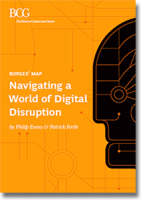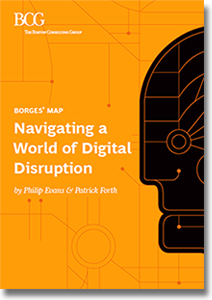Borges’ Map: Navigating a World of Digital Disruption
This report explains the factors underlying these disruptive waves, outlines the new strategic issues they raise, and describes a portfolio of new strategic moves that business leaders need to master.
Digital disruption is not a new phenomenon.
But the opportunities and risks it presents shift over time.
Competitive advantage flows to the businesses that see and act on those shifts first.
We are entering the third, and most consequential, wave of digital disruption. It has profound implications not only for strategy but also for the structures of companies and industries.
Business leaders need a new map to guide them.
In the first wave of the commercial Internet, the dot-com era, falling transaction costs altered the traditional trade-off between richness and reach: rich information could suddenly be communicated broadly and cheaply, forever changing how products are made and sold.
Strategists had to make hard choices about which pieces of their businesses to protect and which to abandon, and they learned that they could repurpose some assets to attack previously unrelated businesses.
Incumbent value chains could be “deconstructed” by competitors focused on narrow slivers of added value. Traditional notions of who competes against whom were upended - Microsoft gave away Encarta on CDs to promote sales of PCs and incidentally destroyed the business model of the venerable Encyclopædia Britannica.
In the second wave, Web 2.0, the important strategic insight was that economies of mass evaporated for many activities.
Small became beautiful. It was the era of the “long tail” and of collaborative production on a massive scale. Minuscule enterprises and self-organizing communities of autonomous individuals surprised us by performing certain tasks better and more cheaply than large corporations. Hence Linux, hence Wikipedia.
Because these communities could grow and collaborate without geographic constraint, major work was done at significantly lower cost and often zero price.
Smart strategists adopted and adapted to these new business architectures. IBM embraced Open Source to challenge Microsoft’s position in server software; Apple and Google curated communities of app developers so that they could compete in mobile; SAP recruited thousands of app developers from among its users; Facebook transformed marketing by turning a billion “friends” into advertisers, merchandisers, and customers.
Now we are on the cusp of the third wave: hyperscaling. Big - really big - is becoming beautiful. At the extreme - where competitive mass is beyond the reach of the individual business unit or company - hyperscaling demands a bold, new architecture for businesses.
What’s Related



Favorites





